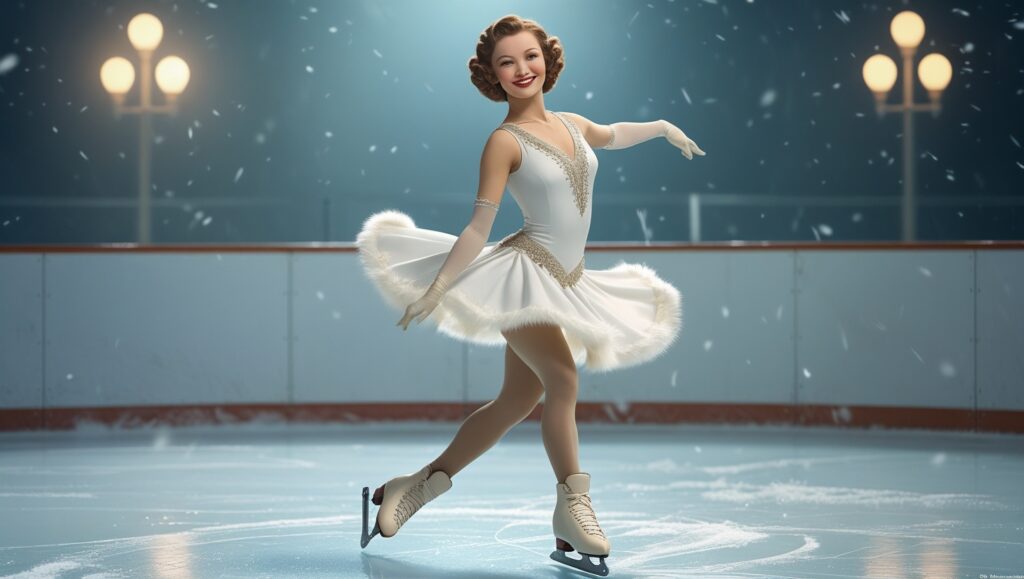Sonja Henie was much more than a figure skater.
She was a global icon, an Olympics legend, and a Hollywood star.
His influence on the sport and entertainment world of figure skating is still felt today.
Born on April 8, 1912, in Oslo, Norway, Sonia grew up in a wealthy and supportive family.
His father, Wilhelm Heini, was a fur trader and former cycling champion, who recognized his talent early on. He left no stone unturned to provide them with the best coaches, training and opportunities. This strong support and Sonia’s hard work led her on the path to greatness.
Early Skating Career
Sonja Henie burst onto the world stage at the age of just 11, when she competed in the 1924 Winter Olympics in Chamonix, France.
Although she finished in last place, it was the beginning of a remarkable journey.
By the age of 14, he had won his first World Championship in 1927, a title he would go on to win ten consecutive times until 1936.
She also claimed six consecutive European titles from 1931 to 1936.
Her Olympic triumphs are perhaps the most stunning.
Sonja won gold medals at three Winter Olympics:
- 1928 in St. Moritz
- 1932 in Lake Placid
- 1936 in Garmisch-Partenkirchen
This made her the first and only female figure skater to win three Olympic gold medals in a row a record that still stands.
Revolutionizing Figure Skating
Before Heaney, figure skating was a rigorous, technical sport that focused mostly on forced figure skating.
It lacked beauty, rhythm and temperament.
Sonya brought something new to the ice: elegance, charisma and entertainment.
She performed a short skirt, ballet-inspired choreography and a musical routine that stunned both the judges and the audience.
Their demonstrations were no longer just about technology; they told a story.
She trained in ballet and implemented that knowledge into her skating, creating a style that was fluid and expressive.
This blend of athletic prowess and performing arts reshaped the game forever.
Today’s skaters, from Peggy Fleming to Michelle Kwan and Evgeni Plushenko, all follow in her footsteps.
Hollywood Stardom
After retiring from amateur competition in 1936, Henny turned his attention to Hollywood.
She signed with 20th Century Fox and quickly became one of America’s most bankable stars.
His first film, One in a Million (1936) was a hit.
This was followed by several popular films such as Thin Ice (1937), Happy Landing (1938) and Sun Valley Serenade (1941).
Henie brought figure skating to the big screen like no one else had.
His films included light romance, catchy music, and spectacular skating performances on custom-built rinks inside sound stages.
During the Great Depression and World War II, audiences loved these films, which provided an enjoyable escapist experience.
During this period, Sonja became one of the highest-paid actresses in Hollywood.
They also performed in ice shows, often touring with large-scale productions that featured elaborate costumes and synchronized skating routines.
Personal Life
Behind the glamour, Sonja Henie had a complex personal life.
She married three times:
- Dan Topping, a sports executive and co-owner of the New York Yankees (1940–1946)
- Winthrop Gardner, an American businessman (1949–1956)
- Niels Onstad, a wealthy Norwegian shipping magnate (1956–1969)
Her final marriage to Onstad was her most enduring.
Together, they founded the Henie-Onstad Art Centre in Høvikodden, Norway.
The museum still stands today and features contemporary art collections along with exhibits about Sonja’s life.
Equipment, Training, and Skating Style
Sonja Henie was known for her attention to detail.
She used custom leather boots and sharp blades tailored for precision and flexibility.
Her skating style emphasized:
- Freestyle techniques like jumps and spins
- Graceful transitions
- Elegant hand and arm movements
He mastered moves like Camel Spin, Sit Spin and Layback Spin.
Unlike many of his competitors, Heaney trained as hard off the ice as he did on it.
Ballet, stretching, and posture work were a big part of her daily routine.
Due to his disciplined and consistent training, he faced very few injuries in his career.
He built his reputation as a man who prepared carefully and never cut corners.
Retirement and Later Years
By the mid-1950s, Sonja Henny retired from show business.
He focused on art collecting and spent much of his time in Norway and the United States.
She continued to be a public figure, frequently appearing at charity events, museum openings and skating-related functions.
In 1969, he was detected with leukemia.
He died on October 12, 1969, while flying back to Oslo from Paris, at the age of 57.
His body was returned to Norway, where he was buried in Oslo.
Lasting Legacy
Sonja Henie left behind a powerful legacy.
- A three-time Olympic gold medalist
- A ten-time World Champion
- A Hollywood star
- A pioneer of modern figure skating
They helped transform a niche winter sport into a global phenomenon.
He inspired generations of skaters to become both athletes and artists.
His life’s work also helped create bridges between sports, entertainment and culture.
The Heaney-Onstad Art Center, his films and archival skating footage keep his memory alive.
Final Thoughts
Sonja Henie was much more than a figure skater.
She was a trailblazer who combined sports, art and cinema into an unforgettable career.
Whether you know him from Olympic history, old Hollywood movies, or figure skating lore, his name still stands tall today.
Even today, on frozen rinks and movie reels, Sonja Henie’s legacy continues to be beautiful, powerful and unforgettable.

